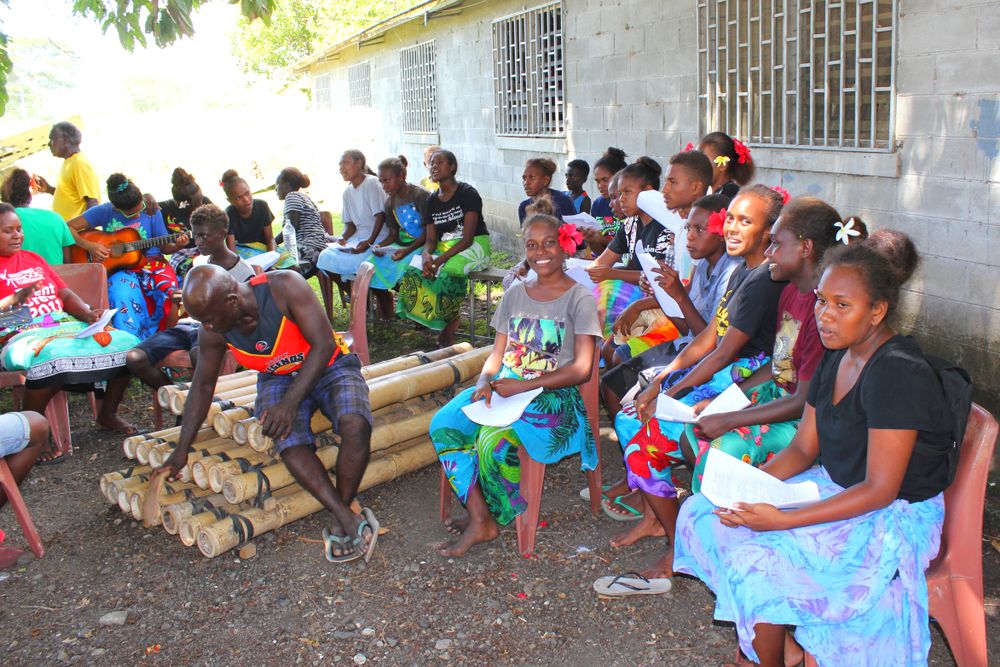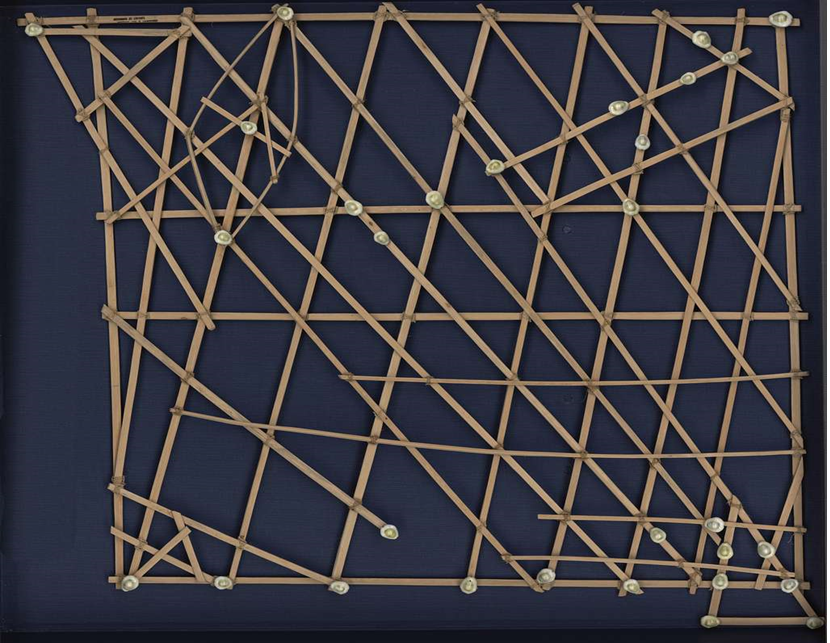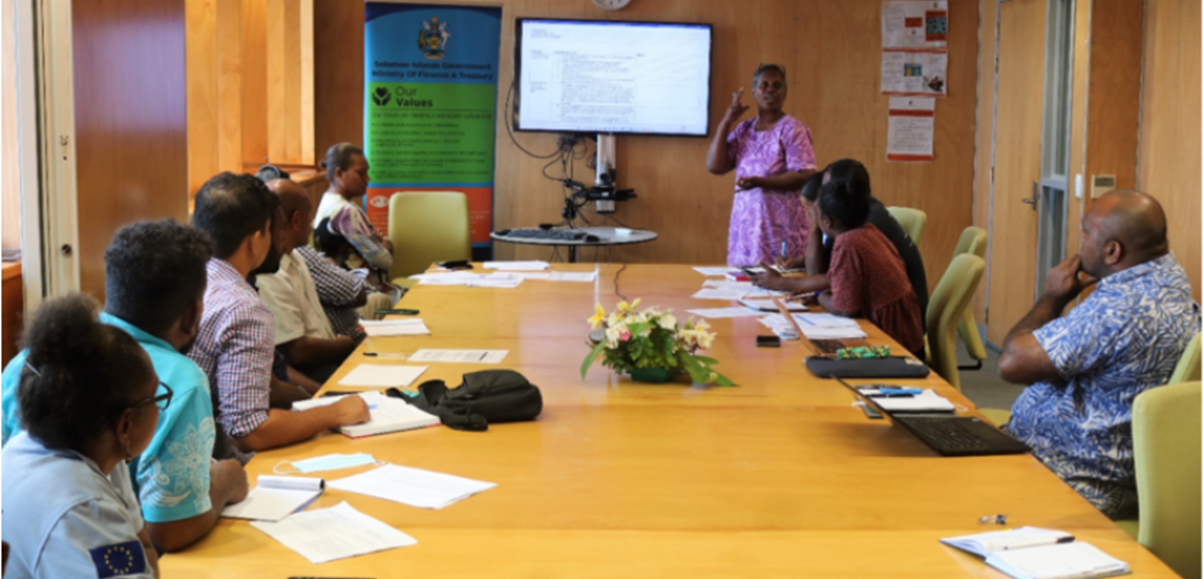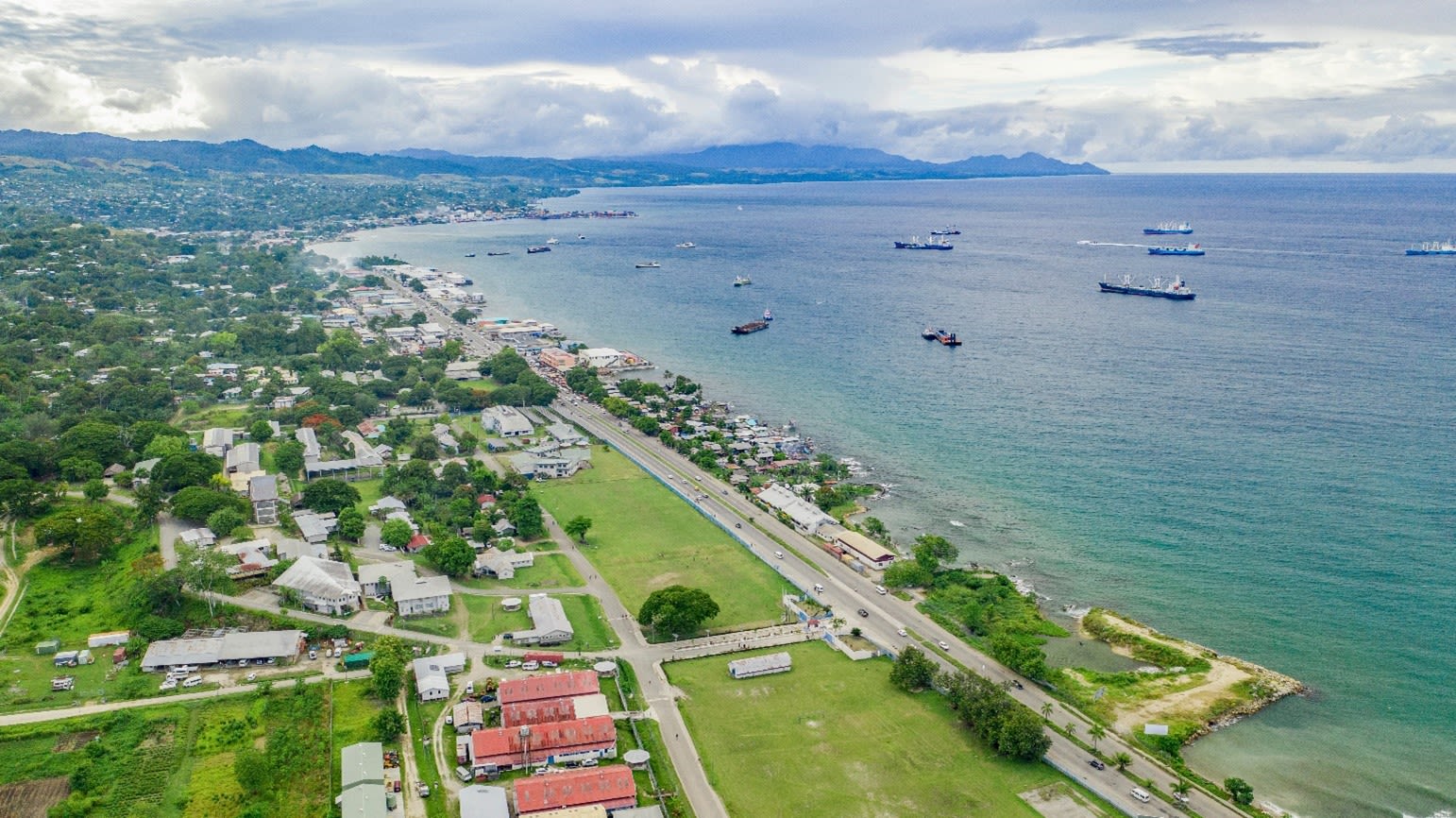SOLOMON ISLANDS
Weaving Stories, Charting a Course: Solomon Islands Moves Forward with Strengthening Their National M&E System
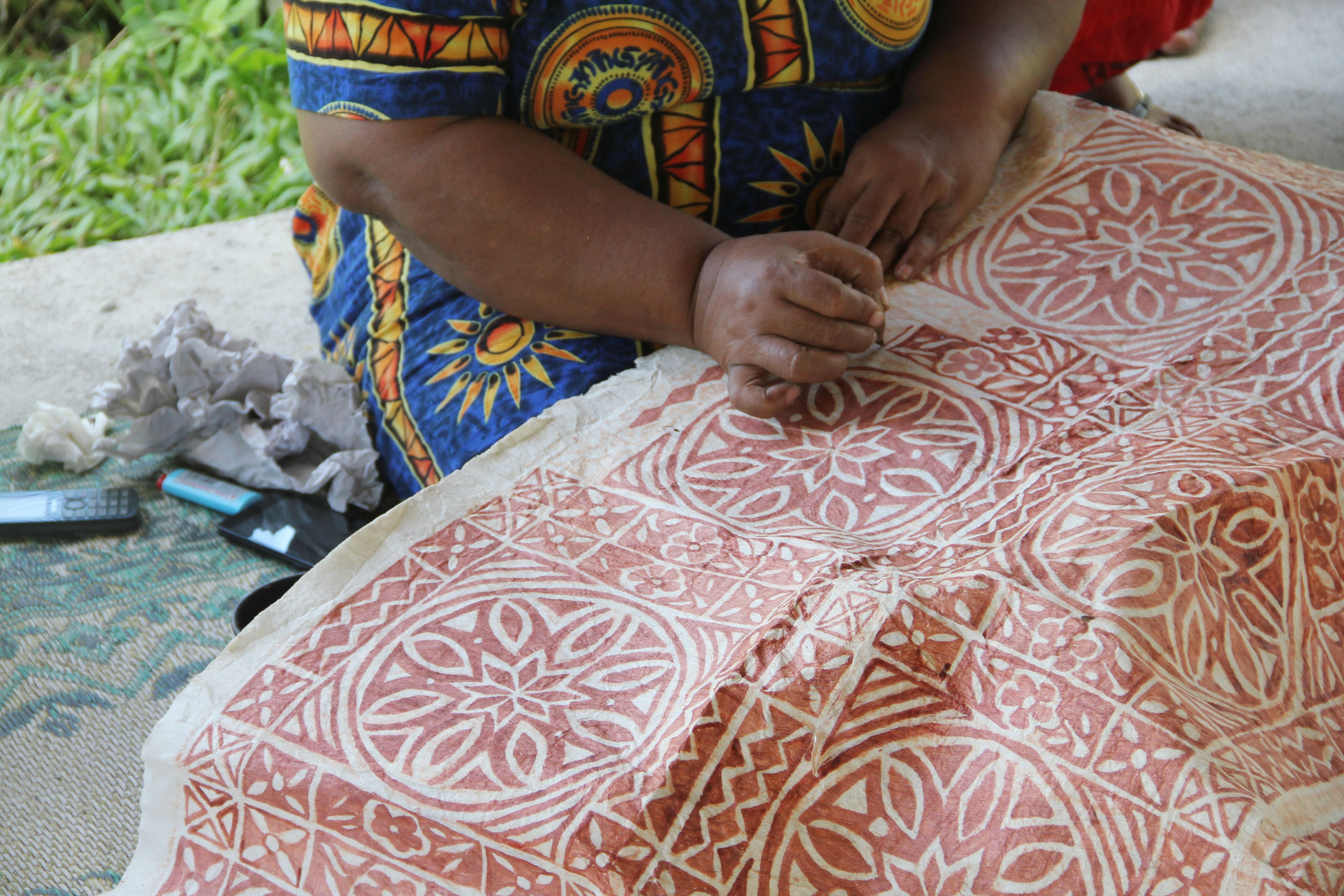
The journey to improve evidence-based decision-making must start with local ownership, local customs and local voices.
In the heart of Santa Cruz Island, surrounded by vibrant purple and yellow tablecloths, an important gathering begins. As the afternoon light streams in, provincial government officers, local NGO representatives and church group members set off on a journey of storytelling. Seated in huddled groups, the participants dive into narratives – some intricate and lengthy, others quick and impactful. Laughter echoes, punctuating moments of unanimous agreement.
They are participating in a tok stori process to help the Solomon Islands government strengthen its national monitoring and evaluation (M&E) system. Tok stori, a Melanesian concept, encapsulates the essence of everyday Solomon Islands life – weaving tales, crafting a collective narrative, and deciphering the intricacies of existence. Beyond a cultural norm, it serves as a potent research method, placing traditional techniques at the forefront and amplifying local voices. Here, in this dynamic space, people forge connections, share knowledge, and reach consensus – a tapestry of stories shaping the future.
The journey to improve evidence-based decision-making must start with local ownership, local customs and local voices. Context- and culturally-specific methods and the local ownership of the process is a foundational part of the Global Evaluation Initiative’s (GEI) systems-based approach to strengthening national M&E systems. GEI’s role is to provide advisory and technical guidance, leveraging the best practices of its respected network of partners and donors. This is the approach GEI took when it began working with Susan Sulu, Permanent Secretary of the Ministry of National Planning and Development Coordination (MNPDC) of the Solomon Islands.
MNPDC requested support from GEI to conduct a Monitoring and Evaluation Systems Analysis (MESA) diagnostic to identify capacity constraints and opportunities for strengthening the national M&E system. The MESA is a diagnostic tool that guides country stakeholders (e.g., government entities, evaluation professionals, civil society) in gathering, structuring and analyzing information on the current capacity of their country’s M&E ecosystem. A MESA is not an end, but rather a means to inform improvements to a country’s M&E systems. It is comprehensive, but flexible – able to be adapted to local contexts, needs and goals.
A GEI Team1 helped the government of the Solomon Islands conduct a MESA, centering the tok stori approach and other Pacific methods. This proved more effective in gathering relevant information, encouraging open and honest communication by stakeholders. This process also showcased the adaptability and flexibility of the MESA diagnostic process.
“In my role as a planner, as an advisor to government, I often look for the data, and the information to support what recommendations are put forward in terms of policy recommendations that you put forward to government. But also more on a more regular annual basis is the fact that we formulate the government's capital budget, the government's development budget. And for that, we wanted the resource allocation to be evidence-based, such that … programs are actually addressing the most needful places and is actually helping the most vulnerable ... And for that, I needed the evidence. But it existed in little pockets everywhere. And so, I realized that I need to sort out some sort of systematic system first to help me get that evidence before I can be able to effectively inform policy, effectively inform decision making. And so that was the start of the journey that we had with GEI.”
1 Led by the consulting firms Alinea International (Australia) and Dignity Pasifik (Solomon Islands)
About the Solomon Islands
General info
The Solomon Islands is a country located in the western South Pacific Ocean and is comprised of 992 islands. In 2021, Solomon Islands Gross Domestic Product (GDP) per capita was US$2,304.80,2. The formal economy is small as of most of the employed population engages in informal or subsistence activities. As of January 1, 2023, Solomon Islands had a population of 732,441, with over 80% living in vulnerable coastal rural areas3. The population is young, with a median age of 23.5 years4. Approximately 25% of the population lives in poverty5. Solomon Islands faces considerable climate change and extreme weather event risks due to its position in the “Pacific Ring of Fire” and cyclone zone. The Solomon Islands has been experiencing sea level rises at almost three times the global average, around 7-10mm per year, since 1993.6
M&E Background
The National Development Strategy (NDS) 2016–2035 of the Solomon Islands outlines commitments to human and economic development, peace and security, environmental protection, and adherence to the Paris Agreement on climate change. Aligned with the UN 2030 Agenda and the Sustainable Development Goals, the NDS emphasizes the need for robust national monitoring and evaluation (M&E) systems to track progress effectively. There is a growing demand for performance information in the country, with the government taking steps to promote accountability, transparency, and evidence-based policymaking. While M&E has gained some traction throughout the government, its integration into the organizational culture is still in its early stages and further efforts are required to create a whole-of-government M&E system, as was recognized by all MESA participants.
What is MESA?
The Monitoring and Evaluation Systems Analysis (MESA) is a diagnostic tool that guides country stakeholders (e.g., government entities, evaluation professionals, civil society) in gathering, structuring and analyzing information on the current capacity of their country’s M&E ecosystem. It helps identify what is working well and what needs to be improved. The MESA leads to a report that can serve as a guide for preparing a capacity development strategy and/or a roadmap to strengthen the economic, political, and social context that enables M&E to flourish. The report can also be used as a baseline of the country’s M&E situation, against which progress can be measured over time.
While there are many ways to carry out such a diagnostic, the GEI MESA adopts a mixed-method approach, using both quantitative and qualitative methodologies. It is comprehensive, but flexible – able to be adapted to local contexts, needs and interests. The MESA can be used with a view to analyzing the entire M&E ecosystem or only specific elements; it can be customized not only for countries, but also for subnational units or line ministries.
2 https://data.worldbank.org/indicator/NY.GDP.PCAP.KD.ZG
3 https://worldpopulationreview.com/countries/solomon-islands-population
4 United Nations Population Division. 2013. World Population Prospects: United Nations: New York
5 https://data.worldbank.org/country/SB
6 https://www.telegraph.co.uk/global-health/climate-and-people/climate-change-soloman-islands-rising-sea-levels

From Rebbilib to Report: MESA Methodology in the Solomon Islands
The MESA process that was implemented in the Solomon Islands was designed as an inclusive, contextualized study framed around the Pacific concept of rebbilib (navigational sea chart) as a metaphor for discovery and learning, drawing on indigenous Melanesian approaches.
Alinea International (Australia) and Dignity Pasifik (Solomon Islands) supported the MNPDC to conduct the MESA in consultation with Solomon Islands' national and provincial governments, non-government organizations (NGOs), civil sector organizations (CSOs), faith-based organizations, and donors and development partners. The process was led by a technical working group and supported by a Solomon Islands Government (SIG) Advisory Committee.
The MESA employed qualitative indigenous methodology for data collection and analysis, fostering a collaborative process for determining MESA objectives, designing its scope, conducting the study, and identifying gaps and opportunities for future projects.
Fig. Rebbilib, a traditional navigation sea chart from the Pacific.
The fact that the GEI was clear on a tool that could be used really helped to solve the problem. And so, for me, the MESA sort of was a solution to a challenge that we faced. But we were also careful in the fact that we wanted the MESA diagnostic to be responsive to the situation. And so, we really had the conversation, and I'm thankful for the fact that GEI has been engaging, and also accommodating of how we wanted to contextualize the MESA tool, such that it actually responds to our country's context.
The MESA followed five steps in the Solomon Islands:
- Designing the study (indigenous method: faola7)
Based on the GEI MESA Guidance Note (2022)8 and consultations with key SIG departments, the team adapted the MESA tool for the context of Solomon Islands, defining the scope in the form of key assessment areas and questions. - Preparations for conducting the study
The GEI team developed documents for stakeholder consultations, including an introduction of the MESA, the respondent consent form, the ethics form, and data collection tools. Three research teams were formed, each consisting of three members (one of whom was a team leader). To ensure consistent use of the methodology, a consultation simulation exercise was conducted9. - Data collection (indigenous method: tok stori10)
The MESA utilized secondary and primary data sources. Secondary data were collected through a review of national and sectoral policies, strategies and plans, M&E reports from development programs and projects, and reports and statistics on Solomon Islands' development issues.
Primary data were collected through Key Informant Interviews and Focus Group Discussions in tok stori sessions. During the MESA, many stakeholders were consulted: 25 national government organizations, provincial governments in eight provinces, NGOs, representatives of the private sector, and development partners11. - Data analysis (indigenous method: iola12)
The Key Informant Interviews and Focus Group Discussions were recorded, transcribed and translated into English, as necessary. The consultants conducted a literature review and a content analysis of the transcripts. The consultants and the Core MESA Team also conducted reflection sessions and identified findings using the Strengths, Weaknesses, Opportunities, and Threats (SWOT) framework. Additionally, the fishbone diagram technique was employed to discover cause-and-effect relationships and to develop possible solutions. - Sense-making and validation of MESA findings (indigenous method: rara'aba, or calming of nerves meeting)
The draft MESA report, with proposed M&E capacity-strengthening pathways, was presented to MESA stakeholders for validation. The final report will be endorsed by the MESA Advisory Committee prior to a high-level launch event.
The draft MESA report, with proposed M&E capacity-strengthening pathways, was presented to MESA stakeholders for validation. The final report, endorsed by the MESA Advisory Committee, was launched during a high-level event and is now available online.
7 In the Gula’alaa language, faola means ‘weaving in action’. Faola provides the parameters of the mat or basket that is woven. The boundaries within which the weaving happens must be determined so that weaving is done within the given scope.
8 Available at: https://www.globalevaluationinitiative.org/mesa
9 MNPDC press release available at: https://solomons.gov.sb/mnpdc-rolls-out-historic-monitoring-evaluation-systems-analysis-mesa-diagnostic-studymnpdc-rolls-out-historic-monitoring-evaluation-systems-analysis-mesa-diagnostic-study
10 Tok stori is a Melanesian term for what Solomon Islanders do everyday – telling stories, creating a joint narrative, and making sense of life.
11 Participants were individuals who currently perform or are expected to perform M&E functions and those that use M&E evidence in decision-making, including SIG permanent secretaries, provincial premiers, members of provincial assemblies, provincial secretaries, heads of divisions, planning and project officers, M&E units where they exist, data managers, and personnel who perform M&E functions. Selected personnel from NGOs and the wider donor community were also included.
12 Iola (canoe) is an indigenous approach that leads the researcher to organize the research along the divisions of the canoe: the back end (content analysis); the midsection (preliminary thematic findings), and the front end (sense-making and data verification).
Navigating the Course to M&E System Transformation
Efforts to transform Monitoring and Evaluation (M&E) systems often hinge on the pivotal task of addressing fragmentation among national stakeholders. In the Solomon Islands, stakeholders were able to establish connections with teams and individuals they had never worked with before through participating in the MESA process. The process also gave credibility to the efforts of the Ministry of National Planning and Development Coordination to promote evidence-based decision-making within the Solomon Islands Government (SIG) – creating pathways for the ministry to continue promoting the development of an effective and resilient national M&E system.
Another complementary impact from the MESA process was the identification of a substantial amount of monitoring and evaluation data from projects in the Solomon Islands, which were sponsored by international donors. Development partners, including the Asian Development Bank, Australia Department of Foreign Affairs and Trade, New Zealand Ministry of Foreign Affairs and Trade, United Nations Development Program, and the World Bank, actively commission and oversee evaluations in the Solomon Islands and the broader Pacific Region. Despite the dispersion of data across various organizations and ministries, leveraging these evaluations can significantly contribute to evidence-based decision-making for the SIG.
For instance, the MESA process shed light on the Ministry of Environment's collection of significant climate change data, which, unfortunately, lacks systematic sharing with other ministries. This untapped data could now play a crucial role in aiding the Ministry of Planning with national objectives/programs related to risk mitigation, adaptation, disaster preparedness, and more.
Insights from MESA consultations and validation workshops, led by the GEI and MNPDC teams, have directly informed a Strategic Implementation Plan, with specific activities to be implemented over the next five years. The priority actions for the initial year encompass advancing the M&E policy, facilitating the training of MNPDC M&E specialists, creating an inventory of existing databases for NDS reporting, and establishing a comprehensive repository of existing evaluations. These actions represent crucial strides in enhancing M&E systems and functions in the Solomon Islands.
To sustain momentum, the MNPDC team remains committed to fundraising for the Strategic Implementation Plan, complemented by ongoing support from GEI's local consultants who will play a pivotal role in initiating strategy implementation and coordination. This collaborative approach ensures seamless transition from strategy development to practical, impactful outcomes in the ongoing transformation of M&E systems in the Solomon Islands.
We see the MESA as a means to an end, and that end, or that subsequent point that we want to reach is enabling us to build up a resilient evaluation system. So that is where we want to get to. But the MESA is important to help us understand how we approach getting to that end point.
The other critical side of the coin is implementing the capacity development plan that would result from the MESA diagnostics self. And I believe that is where the most influence in terms of helping to build a resilient evaluation system would come. Because with the diagnosis, yes, it helps our understanding, but not unless we implement the capacity development plan, would we get to a robust and resilient evaluation system.
------------------------------
More resources: Susan Sulu interview (Part 1 and Part 2) | Mesa Report | Strategy document
Story by Maria Fyodorova
